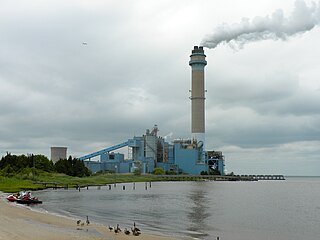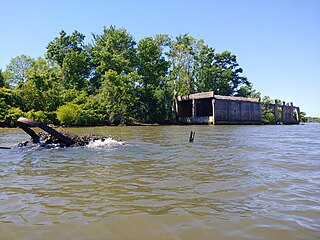
Conway is the 18th most populous city in South Carolina. The population was 24,849 at the 2020 census, up from 17,103 in the 2010 census. It is the county seat of Horry County and is part of the Myrtle Beach metropolitan area. It is the home of Coastal Carolina University.

The Virgil C. Summer Nuclear Power Station occupies a site near Jenkinsville, South Carolina, in Fairfield County, South Carolina, approximately 20 miles (32 km) northwest of Columbia.

Tuckahoe Bay is located in Horry County, South Carolina in the Nixonville Quadrangle of South Carolina. It is a Carolina bay, which is similar to a swamp with an oval shape. The bay is next to the Covington Lake and Waterford Plantation subdivisions in the Carolina Forest neighborhood of Myrtle Beach, South Carolina. It is noted that the flora in the bay is noticeably shorter than that of the surrounding area. This is due to the difference in soil type. Tuckahoe Bay has a Jo soil type, or Johnston Loam.
Santee Cooper, also known officially from the 1930s as the South Carolina Public Service Authority, is South Carolina's state-owned electric and water utility that came into being during the New Deal as both a rural electrification and public works project that created two lakes and cleared large tracts of land while building hydro-electric dams and power plants. Its headquarters are located in Moncks Corner, South Carolina.

The Nanticoke Generating Station was a coal-fired power station in Nanticoke, Ontario in operation from 1972 to 2013. It was the largest coal power station in North America and, at full capacity, it could provide 3,964 MW of power into the southern Ontario power grid from its base in Nanticoke, Ontario, Canada, and provided as much as 15% of Ontario's electricity.

The B.L. England Generating Station, also called Beesley's Point Generating Station, was a power plant in Upper Township, Cape May County, New Jersey, United States, on the Great Egg Harbor River. The facility provided approximately 450 megawatts of generating capacity from three generating units. Two units burned coal (and up to 7 percent Tire-derived fuel) and the third unit burned bunker C oil. Its large smokestack, altered to resemble a lighthouse, contained a sulfur dioxide scrubber which removed the SO2 from the flue gas and converted it into gypsum, which can be sold. The scrubber allowed the two coal units to use less expensive high sulfur coal from West Virginia.

Widows Creek Fossil Plant was a 1.6-gigawatt coal power plant, 4.8 miles (7.7 km) east of Stevenson, Alabama, USA. The plant, operated by the Tennessee Valley Authority, generated about nine billion kilowatt-hours of electricity a year. It had one of the tallest chimneys in the world at 305 metres (1,001 ft), which was built in 1977, and was removed December 3, 2020 in a controlled demolition. Along with the Chimney of the Harllee Branch Power Plant, it is the tallest chimney to be demolished in the United States.

Cumberland Fossil Plant is a pulverized coal-fired power station located west of Cumberland City, Tennessee, US, on the south bank of Lake Barkley on the Cumberland River. Owned and operated by Tennessee Valley Authority (TVA), it has a gross capacity of 2,470 MW, and is the most powerful power station in Tennessee.

Kingston Fossil Plant, commonly known as Kingston Steam Plant, is a 1.4-gigawatt coal-fired power plant located in Roane County, just outside Kingston, Tennessee on the shore of Watts Bar Lake. It is operated by the Tennessee Valley Authority. The plant is known for the Kingston Fossil Plant fly ash spill which occurred in December 2008.

The Gibson Generating Station is a coal-burning power plant located at the northernmost end of Montgomery Township, Gibson County, Indiana, United States. It is close to the Wabash River, 1.5 miles (2.5 km) southeast of Mount Carmel, Illinois, 2 miles (3.2 km) south of the mouth of the Patoka River, and 4 miles (6.5 km) south of the mouth of the White River. The closest Indiana communities are Owensville 7.5 miles (12 km) to the southeast of the plant, and Princeton, 10.5 miles (17 km) to the east. With a 2013 aggregate output capacity among its five units of 3,345 megawatts, it is the largest power plant run by Duke Energy, and the tenth-largest electrical plant in the United States. Given the closure of the Nanticoke Generating Station in Ontario, in 2013, the Gibson Generating Station became the largest coal power plant in North America by generated power.

Muskingum River Power Plant was a 1.5-gigawatt coal power plant, owned and operated by American Electric Power (AEP). It was located on the west bank of Muskingum River, about 4 miles (6 km) northwest of the town of Beverly, Ohio in Washington County, Ohio. At its peak, the plant powered three million households. The plant operated from 1953 until ceasing generation in 2015.

Pinopolis Dam is a dam in Berkeley County, South Carolina.

Crawford Generating Station was a coal−fired power plant built in 1924. It was located in the South Lawndale community of Chicago, Illinois.
Sandow Power Plant was a 1.1-gigawatt coal power plant located southwest of Rockdale, Texas in Milam County, Texas. It was operated by Luminant, a subsidiary of Vistra Corp. The plant closed in 2018.
R.E. Burger Power Station was a 568 megawatt (MW), coal power plant located south of Shadyside, Ohio in Belmont County, Ohio. The plant closed in 2011. It was operated by FirstEnergy.

Ferguson is a ghost town, a former lumber-mill settlement, in Orangeburg County, South Carolina. It was a company town owned by Northern lumbermen Francis Beidler and Benjamin F. Ferguson, both of Chicago. The co-CEOs founded the Santee River Cypress Lumber Company in 1881 for the purpose of harvesting old-growth timber from blackwater river wetlands in central South Carolina. The firm, which controlled 165,000 acres (67,000 ha) of land, concentrated its efforts on bald cypress timber.

Conesville Power Plant was a 2-gigwatt, coal power plant located east of Conesville, Ohio in Coshocton County, Ohio. Its units were co-owned at the time of its closing by American Electric Power (AEP) and AES Ohio Generation. All plant operations were handled by AEP. Conesville began operations in 1957 and ceased generation in April 2020.
Cross Generating Station is a 2,390 MW, four unit coal-fired power station located in Pineville, South Carolina. It is owned by Santee Cooper, formally known as the South Carolina Public Service Authority. The nameplate capacity of each unit is 590.9 MW, 556.2 MW, 591 MW, and 652 MW respectively. In 2016, Cross switched from using higher quality bituminous coal, to refined coal, which is a lower quality coal that is refined to release less toxins and is backed by the US government. The future of the plant has become more uncertain due to downward trends in use, talks of shuttering the station, and converting it to natural gas. However, no official statements have been made on the future of the plant.

The Nukegate scandal was a political and legal scandal that arose from the abandonment of the Virgil C. Summer nuclear expansion project in South Carolina by South Carolina Electric & Gas (SCE&G) and the South Carolina Public Service Authority in 2017. It was the largest business failure in the history of South Carolina. Before its termination, the expansion was considered the harbinger of a national nuclear renaissance. Under joint ownership, the two utilities collectively invested $9 billion into the construction of two nuclear reactors in Fairfield County, South Carolina from 2008 until 2017. The utilities were able to fund the project by shifting the risk onto their customers using a state law that allowed utilities to raise consumers' electricity rates to pay for nuclear construction.














